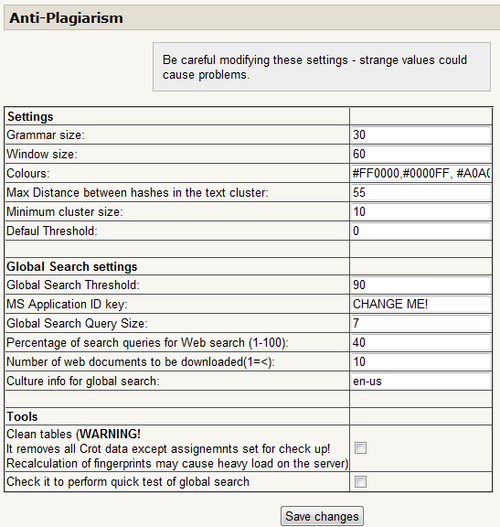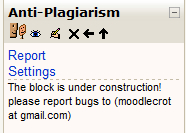Plagiarism is a perennial problem for writing instructors. As an instructor you want to ensure that your students are not plagiarizing anyone's work. With the advent of the Internet, more and more material is available for students to access, and it is growing on a daily basis. If you find something that you may feel is not consistent with the student's normal production, you can search the Internet for it, and you may find the original source. However, this can prove to be a time-consuming task.
The most basic way to search for plagiarized material is to simply copy and paste the suspected sentence or paragraph into a search engine and see what comes up. This is often the only way for many of us to find plagiarized material. Sergey Butakov began development of a new block for Moodle called Crot. The block is intended as an anti-plagiarism measure and has two functions. The first function is that it will search local-level submissions to find possible matches. The second function uses the Internet to search for similar work online. In both of these modes, the results will be displayed next to the original submission allowing you to compare the suspected work with another source.
The Crot block is currently in development and it only works with the Upload a single file type assignments now, but it can be very useful for many teachers in many situations. You will need site administration privileges to install this block. The link to download the file is http://moodle.org/mod/data/view.php?d=13&rid=2141filter=1.
Once Crot is installed, go to Site administration | Modules | Blocks | Manage blocks | Anti-Plagiarism. In the settings column of the Anti-Plagiarism block click on the Settings link. Clicking on this link will take you to the settings for the Anti-Plagiarism block. You should see something that looks like this:

Initially, you will want to leave the settings as they are. Once you become familiar with the block, then you may want to play with the window size, colors, and so on.
Under the global search settings you will notice an MS Application ID Key entry. In the textbox you can see the phrase CHANGE ME! entered. You will need to have an MS Application ID number to use this block. To create Microsoft Bing MS Application ID, you'll need to go to this link http://www.bing.com/developers/appids.aspx and follow the instructions on how to create an AppID. When you make an AppID, your new ID number will be immediately available. Once you have that number, copy and paste it into the MS Application ID Key textbox.
Once you have your ID Key entered go to the Tools section and find the option called Check It to perform quick test of global search, select the checkbox, and click on Save changes. If everything has been set up correctly and your Internet connection is functioning properly, you will see a series of test results from the search. You will see a message telling you the test is complete. When you click on OK, you will be brought back to the block management page.
Now go to the course in which you want to enable the new block. Once in the course, click on the Turn editing on button. Find the Blocks drop-down menu, click on it, and find the Anti-Plagiarism option. This will enable the block in the course. The screenshot of the block is as follows:

As you can see, there are two options here: Report and Settings.
First you will click on the Settings link. Once you click on this, you will be taken to the list of all the Single file to upload assignments. The next screenshot shows this:

You can see that there are three columns. The first column lists the name of the Assignments available for checking. The second column, Local, allows you to search local files to see if there has been any plagiarism inside the course. The third column, Global, will perform the same action using an Internet search. The block will scan everything that has been checked. As you can see here, we have made our selections, and we will be checking our Eastern European Music assignment both locally and globally. Now all we need to do is click on the Save button.
Once we click on the Save button, we will receive a message telling us that the anti-plagiarism assignment has made the appropriate changes to the settings.
We will be brought back to the course front page. Now we need to click on the Report link in the Anti-Plagiarism block.
After clicking on the Report link you will be brought to the Anti-Plagiarism assignments page. There'll be a drop-down menu titled Select the Assignment in the top center of the page. Pressing on the drop-down menu will list all the assignments that have been selected for scanning by the Anti-Plagiarism block. Choose the assignment you wish to scan. The scan will take place the next time the cron.php jobs runs. Once the Cron has run, you will see a report determining whether or not something has been plagiarized or has a high percentage of similar content.
You will see one of two screens. The first one you see is seen in the next screenshot:

There are two reasons you may see this screen. The first is that no plagiarism has been detected. The other possibility is that the cron.php may not have been run yet. If you have site administration privileges, run the cron.php and this should be updated. One thing that is important to note is that, depending on the number of assignments and size of the site, it may take a while to run the script. Be patient.
The second screen is shown in the next screenshot:

Here, you can see three columns. The first column shows the name of either the local source or the global source. Local sources list the profile name of the person who submitted it. Global sources are headed with WWW: and supply a link to the site. The second column shows the source of the document. This may be the course it came from or a document from the Web. As you can see here, seven documents are Web document, and one is a local document from the Testing Writing course. The final column shows the percentage of matched words in the documents. As we can see here, there are several sites that appear to have plagiarized large portions of an original document. We can also see that Two Student in the Testing Writing course has submitted a document with a 44% match rate.
Clicking on the local search link that revealed a high match rate by Two Student, we will be shown both works side by side. The original post will be shown on the left-hand side and the comparison item selected will be shown on the right-hand side. After clicking on the link, we can see the following screen:

Note
Source: Wikipedia. Retrieved on August 8, 2010 from: http://en.wikipedia.org/wiki/Polish_folk_music#Traditional_music
In an amazing coincidence, or a rather blatant plagiarizing attempt, Two Student has written an almost identical paper to One Student. From here, as an instructor you can make decisions as to how to best deal with the students depending on the class and the situation.
Clicking on any of the global links will create an identical screen to the local link, except that it will show text from the web document.
This new block, even though it's still in development, offers instructors an extremely useful tool in hunting down and stopping plagiarism in their courses. It is worth taking the time to install, set up, and use in your classes.
